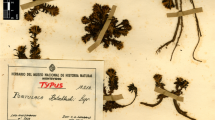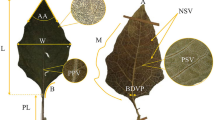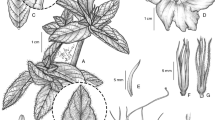Summary
A new species of Dioscorea from South Africa, D. strydomiana Wilkin, is described and illustrated. It differs from the related species D. elephantipes (L’Hér.) Engl., D. hemicrypta Burkill and D. sylvatica Eckl. in its tuber surface, leaf morphology, texture and habit, male flower tepal, filament and pistillode size, the length of the stipe between the ovary apex and the torus in female flowers and in capsule shape. Just two populations and c. 200 individuals in total exist, and significant threats have been reported, making D. strydomiana critically endangered. Thus its conservation and sustainable use are discussed.





Similar content being viewed by others
References
Abbott, A. T. D. (1998). The rediscovery of Dioscorea brownii. PlantLife 18: 29.
Archibald, E. E. A. (1967). The genus Dioscorea in the Cape Province West of East London. J. S. African Bot. 33: 1 – 46.
Baker, J. G. (1897). Dioscoreaceae. In: W. T. Thistleton-Dyer (ed.), Flora Capensis. Lovell Reeve & Co., London.
Born, J., Linder, H. P. & Desmet, P. (2007). The Greater Cape Floristic Region. J. Biogeogr. 34: 147 – 162.
Burchell, W. J. (1824). Travels in the Interior of Southern Africa. Vol. 2. Longman, Hurst, Rees, Orme & Brown, London.
Burkill, I. H. (1939). Notes on the genus Dioscorea in the Belgian Congo. Bull. Jard. Bot. État. Bruxelles 15: 345 – 392.
____ (1952). Testudinaria as a section of the genus Dioscorea. J. S. African Bot. 18: 177 – 191.
____ (1960). The organography and the evolution of the Dioscoreaceae, the family of the yams. Bot. J. Linn. Soc. 56: 319 – 412.
Coursey, D. G. (1967). Yams: An Account of the Nature, Origins, Cultivation and Utilisation of the Useful Members of the Dioscoreaceae. Longmans, London.
Govaerts, R. & Wilkin, P. (2009). World Checklist of Dioscoreaceae. The Board of Trustees of the Royal Botanic Gardens, Kew. Published on the Internet, http://www.kew.org/wcsp/monocots/. Accessed 16 May 2009.
Hammer, Ø. & Harper, D. A. T. (2006). Palaeontological Data Analysis. Blackwell, Oxford.
____, ____ & Ryan, P. D. (2001). PAST: Palaeontological Statistics Software Package for Education and Data Analysis. Palaeontologia Electronica 4. Available at http://palaeo-electronica.org/2001_1/past/issue1_01.htm.
Hurter, P. J. H. (2003). A new pachycaul Dioscorea species from Mpumalanga Province, South Africa and its conservation. Aloe 40: 73 – 75.
IUCN (2001). IUCN Red List Categories and Criteria. Version 3.1. Prepared by the IUCN Species Survivial Commission, Gland, Switzerland & Cambridge, UK.
Knuth, R. (1924). Dioscoreaceae. In: A. Engler (ed.), Das Pflanzenreich IV. 43. Reprinted 1957, H. R. Engelmann (J. Cramer), Weinheim/Bergstr., Germany.
Kulkarni, M. G., Street, R. A. & van Staden, J. (2007). Germination and seedling growth requirements for propagation of Dioscorea dregeana (Kunth) Dur. and Schinz — A tuberous medicinal plant. S. African J. Bot. 73: 131 – 137.
Martin, F. W. (1969). The species of Dioscorea containing sapogenin. Econ. Bot. 23: 373 – 379.
Miege, J. (1968). Dioscoreaceae. In: F. N. Hepper (ed.), Flora of West Tropical Africa, ed. 2, pp. 144 – 154. Crown Agents, London.
____ & Sebsebe D. (1996). Dioscoreaceae. In: S. Edwards, Sebsebe D. & I. Hedberg (eds), Flora of Ethiopia and Eritrea, Vol. 6, Hydrocharitaceae to Araceae, pp. 55 – 62. The National Herbarium, Biology Department, Science Faculty, Addis Ababa University, Addis Ababa and Department of Systematic Botany, Uppsala University, Uppsala.
Milne-Redhead, E. (1975). Dioscoreaceae. In: R. M. Polhill (ed.), Flora of Tropical East Africa. Crown Agents, London.
N’Kounkou, J. S. (1993). Les Dioscoreaceae du Congo. Fragm. Florist. Geobot., Suppl. 2: 139 – 182.
Rowley, G. D. (2001). Dioscorea. In: U. Eggli (ed.), Illustrated Handbook of Succulent Plants: Monocotyledons, pp. 261 – 272. Springer Verlag, Berlin.
Scott-Shaw, R. (1999). Rare and Threatened Plants of KwaZulu-Natal and Neighbouring Regions. KwaZulu-Natal Conservation Service, Pietermaritzburg, South Africa.
Smith, P. P., Burgoyne, P. & van Wyk, E. (2001). Rare plants Rediscovered in the Northern Cape. (http://www.sabonet.org.za/collecting/collecting_southafrica_northerncape.htm).
Van Wyk, E. & Hurter, P. J. H. (2003). Royal Botanic Gardens, Kew Millennium Seed Bank Project Plant Story: Dioscorea sp. (http://www.kew.org/msbp/plantstories/Dioscorea.htm).
Von Teichman und Logischen, I., van der Schijff, H. P. & Robbertse, P. J. (1975). The genus Dioscorea L. in South Africa. Boissiera 24: 215 – 224.
Wilkin, P. (2001). Yams of South-Central Africa. Kew Bull. 56: 361 – 404.
____ (2009). Dioscoreaceae. In: J. Timberlake (ed.), Flora Zambesiaca 12(2): 109 – 140. Royal Botanic Gardens, Kew.
____, Schols, P., Chase, M. W., Chayamarit, K., Furness, C. A., Huysmans, S., Rakotonasolo, F., Smets, E. & Thapyai, C. (2005). A Plastid Gene Phylogeny Of The Yam Genus, Dioscorea: Roots, Fruits And Madagascar. Syst. Bot. 30: 736 – 749.
Acknowledgements
We would like to thank Johan Hurter, who provided much information on and many photographs of the morphology, habitat, ecology and conservation of Dioscorea strydomiana. Odile Weber and Melanie Thomas translated the Latin diagnosis and Simon Mayo assisted through discussions of species and their delimitation and with PAST. Mervyn Lotter, Tommie Steyn, Karin van der Walt and Andrew Hankey provided information on the conservation and sustainable use of D. strydomiana.
Author information
Authors and Affiliations
Corresponding author
Appendix
Appendix
Rights and permissions
About this article
Cite this article
Wilkin, P., Burrows, J., Burrows, S. et al. A critically endangered new species of yam (Dioscorea strydomiana Wilkin, Dioscoreaceae) from Mpumalanga, South Africa. Kew Bull 65, 421–433 (2010). https://doi.org/10.1007/s12225-010-9227-y
Accepted:
Published:
Issue Date:
DOI: https://doi.org/10.1007/s12225-010-9227-y




